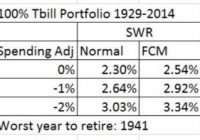Lack Of U.S. Wage Growth Puts These ETFs In Focus
The U.S. is creating jobs fast, but is slow in boosting wage growth. While the buzz about poor wage growth has been doing rounds for long, the unexpected and steepest fall in average U.S. hourly wage for December since 2006 cast a dark cloud over the country’s economic growth story. Average hourly earnings dipped 0.2% sequentially in December, and November average hourly earnings were adjusted down to a 0.2% increase. On a year-over-year basis, average hourly earnings in December were up 1.7%. This indicates that the brighter overall job picture was courtesy of the low-wage category. Thanks to this downbeat data, positive sentiments that shaped up over the U.S. investing in last few months, suffered a brief (seemingly) setback to start 2015. The U.S. dollar dipped against the yen, though slightly, following not-so-enthusiastic payrolls. Several emerging market currencies, however, including Taiwan’s dollar and Indonesia’s rupiah had witnessed a notable ascent following the payroll data. The WisdomTree Emerging Currency ETF ( CEW) , which provides a diversified play on emerging market currencies, added 0.24% on January 9th. Added to this is the inflationary outlook, which will likely remain grave in the days to come due to the unending oil rout. In fact, a beneficial driver like lower greenback also failed to perk up oil investing. Bloomberg analysts envisaged that U.S. consumer prices possibly grew 0.7% year over year in December, the five-year lowest. Most of the market participants started to believe that a solemn inflationary picture and a lackluster wage scenario will delay the hike in U.S. interest rates. We expect this shaky investor sentiment to take charge of the market movement at least for a few days. An upbeat economic data report is urgently needed to lift investors’ mood which is already sinking due to global growth worries. Greenback Gives Up Given the change in the market fundamentals and slide in the greenback following the latest wage data, investors might think about shorting U.S. dollars to take advantage. PowerShares DB U.S. Dollar Bearish Fund (NYSEARCA: UDN ) This fund could be the prime beneficiary of the falling USD as it offers exposure against a basket of world currencies. These include the euro, Japanese yen, British pound, Canadian dollar, Swedish krona and Swiss franc. This is done by tracking the Deutsche Bank Short U.S. Dollar Index Futures Index Excess Return plus the interest income from the fund’s holdings of U.S. Treasury securities. In terms of holdings, UDN allocates nearly 57.6% in euros while 25% collectively is in Japanese yen and British pounds. All of these currencies nudged up after the U.S. wage growth report. The $37.1 million fund charges 80 bps in fees a year from investors. This ETF was up 0.5% on January 9 but failed to sustain the gains after hours. Tilt to Treasuries Like 2014, the 10-year Treasury note too was off to a great start this year with yield slipping even below 2% since October. Notably, this was the best yearly start treasuries experienced in 17 years thanks to a spike in market volatility. Demand for 30-year treasury bonds was so high that yields plunged to the lowest level since July 2012. Investors seeking to ride this environment might take interest in iShares 20+ Year Treasury Bond ETF (NYSEARCA: TLT ) . This ultra-popular long-term Treasury ETF with an asset base of $6.6 billion – TLT – has added more than 4% so far in the New Year. TLT charges 15 bps in fees. Glitters of Gold After a tumultuous 2014, gold finally heaved a sigh of relief. Soft global growth, persistent plunge in oil and now the prospect of a delayed rate hike in the U.S. returned the shine of the yellow metal. On January 9, the SPDR Gold Trust ETF (NYSEARCA: GLD ) – the product tracking gold bullion -added about 1.14%. In the year-to-date frame, this $27.6 billion fund was up 3.2%. The ETF charges 40 bps in fees. Bottom Line As a caveat, investors should note that the outlook is quite rough for the inverse dollar and gold ETF. This is more the case for UDN, which tracks the greenback against currencies like the presently nine-year low euro. These ETFs will turn out winners as long as volatility and downbeat sentiments over the U.S. market prevail. Thus, investors need to be aware of the market at large before considering these investment options.
